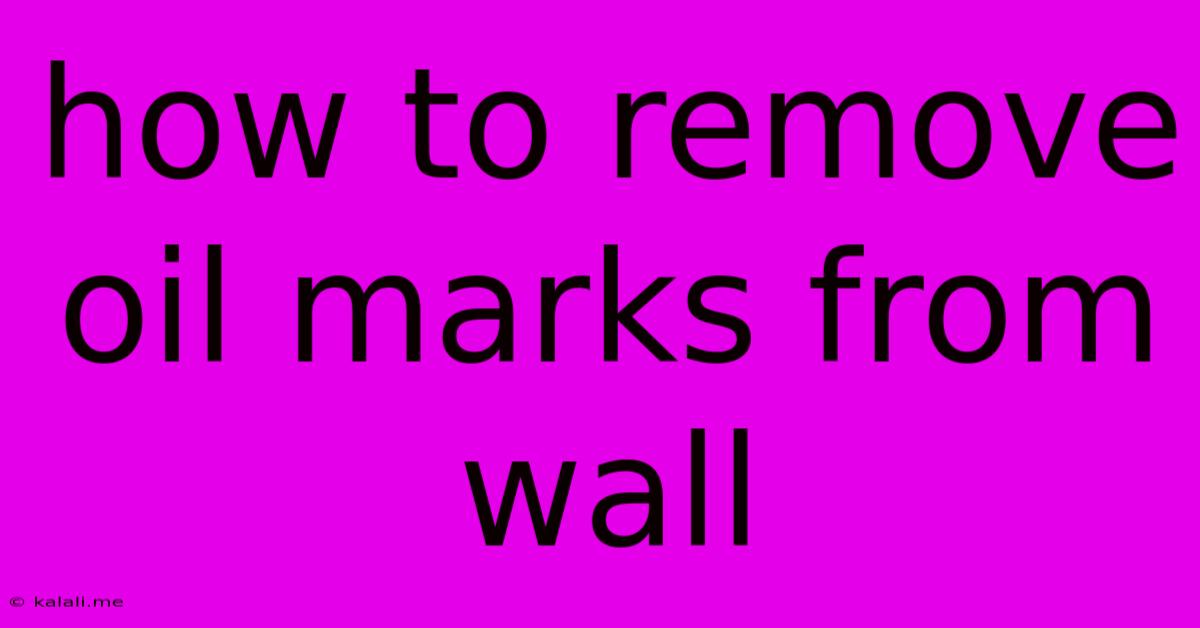How To Remove Oil Marks From Wall
Kalali
May 21, 2025 · 4 min read

Table of Contents
How to Remove Oil Marks From Walls: A Comprehensive Guide
Oil splatters, greasy fingerprints, and stubborn cooking stains – these are common culprits leaving unsightly marks on your walls. Fortunately, removing these oil marks doesn't require a complete repaint. With the right techniques and cleaning solutions, you can restore your walls to their former glory. This guide will walk you through effective methods to banish oil stains from various wall types, ensuring your home looks its best.
Understanding Oil Stains and Your Wall Type
Before diving into cleaning, it's crucial to identify the type of paint on your walls. Different paints react differently to cleaning solutions. Latex paints are generally more durable and easier to clean than oil-based paints. Knowing this will help you choose the appropriate cleaning method and prevent damage. Also, consider the age of the stain; fresh stains are much easier to remove than older, set-in marks.
Methods for Removing Oil Marks from Walls
Here's a breakdown of effective methods, starting with the gentlest options and progressing to stronger solutions:
1. The Gentle Approach: Dish Soap and Water
For fresh oil stains or lightly soiled walls, this is often the most effective and safest starting point.
- What you'll need: Mild dish soap (like Dawn), lukewarm water, a soft cloth or sponge, a clean bucket.
- Method: Mix a small amount of dish soap with lukewarm water in the bucket. Dip your cloth or sponge into the solution, wring it out well to avoid excessive moisture on the wall, and gently blot the stain. Avoid rubbing, which can spread the oil or damage the paint. Rinse the cloth frequently and continue blotting until the stain is lifted. Finally, wipe the area with a clean, damp cloth and allow it to air dry.
2. Baking Soda Paste: A Natural Solution
Baking soda is a mild abrasive that effectively lifts oil and grease. This method is suitable for slightly tougher stains.
- What you'll need: Baking soda, water, a soft cloth or sponge.
- Method: Create a paste by mixing baking soda with a small amount of water. Apply the paste directly to the oil stain and let it sit for 15-20 minutes to absorb the oil. Gently scrub the area with a soft cloth or sponge, then wipe clean with a damp cloth.
3. The Power of Commercial Degreasers: For Stubborn Stains
If the gentler methods fail, a commercial degreaser might be necessary. Always test any degreaser on an inconspicuous area first to ensure it doesn't damage the paint.
- What you'll need: Commercial degreaser (check for wall-safe formulas), a soft cloth or sponge, gloves (recommended).
- Method: Follow the manufacturer's instructions carefully. Generally, you'll spray the degreaser onto the stain, let it sit for the recommended time, and then gently scrub with a soft cloth or sponge. Rinse thoroughly with clean water and dry. Always wear gloves to protect your hands.
4. Magic Eraser: A Last Resort (Use Cautiously!)
Magic Erasers (melamine sponges) are effective at removing stubborn marks, but they are abrasive and can damage certain wall paints. Use this method only as a last resort and test it on a hidden area first.
- What you'll need: A damp Magic Eraser.
- Method: Gently rub the damp Magic Eraser over the oil stain using light pressure. Rinse the eraser frequently. This method should be used sparingly as it can be harsh on paint.
Prevention is Key: Protecting Your Walls
Preventing oil stains is far easier than removing them. Consider these preventative measures:
- Use a range hood: A powerful range hood significantly reduces the amount of grease and oil that gets airborne in your kitchen.
- Cover walls during cooking: Use splash guards or temporary coverings to protect your walls during cooking activities that are likely to produce splatters.
- Regular cleaning: Regularly wiping down walls with a damp cloth prevents oil from setting in and becoming a stubborn stain.
By following these steps and choosing the appropriate method for your wall type and the severity of the stain, you can effectively remove oil marks and keep your walls looking clean and fresh. Remember, patience is key, and starting with the gentlest methods is always recommended.
Latest Posts
Latest Posts
-
South Park The Stick Of Truth Homeless
May 21, 2025
-
How Long Does An Alignment Take
May 21, 2025
-
How Can You Tell If A Platy Is Pregnant
May 21, 2025
-
Can You Put Water In Your Coolant
May 21, 2025
-
Reference Name In India India Visa
May 21, 2025
Related Post
Thank you for visiting our website which covers about How To Remove Oil Marks From Wall . We hope the information provided has been useful to you. Feel free to contact us if you have any questions or need further assistance. See you next time and don't miss to bookmark.